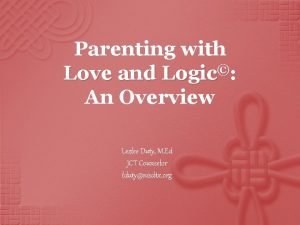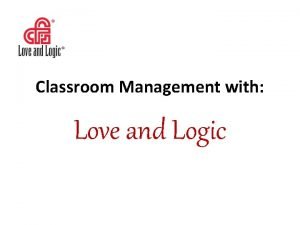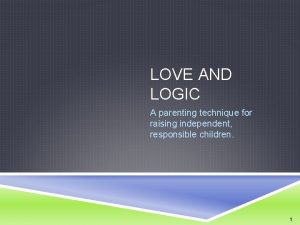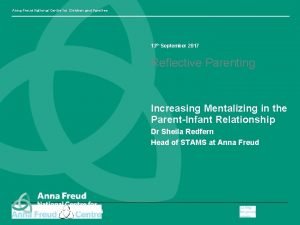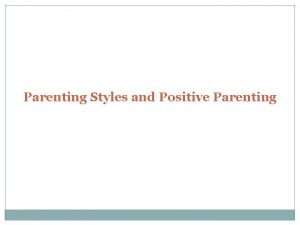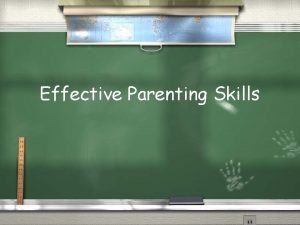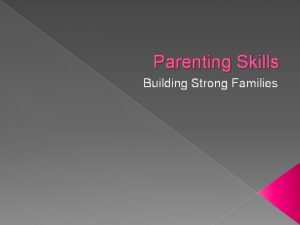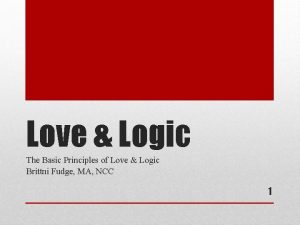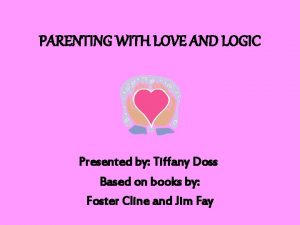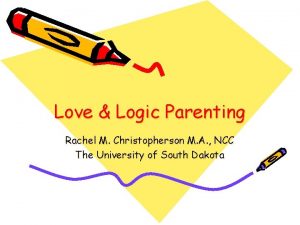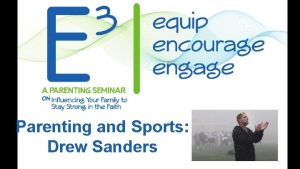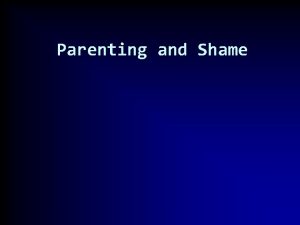Parenting with Love and Logic An Overview Lezlee




















- Slides: 20

Parenting with Love and Logic©: An Overview Lezlee Duty, M. Ed JCT Counselor lduty@nisdtx. org

Love and Logic© is a philosophy founded in 1977 by Jim Fay and Foster W. Cline, M. D. It is a philosophy of raising and teaching children which allows adults to be happier, empowered, and more skilled in positive interactions with all children. Love and Logic© is a way of working with children that puts parents and teachers back in control, teaches children to be responsible, and prepares young people to live in the real world, with its many choices and consequences.

Who can benefit from © Love and Logic ? § Parents § Families § Educators § ALL KIDS!

Goals of Parenting Raise children who are: § § § Independent Problem solvers Critical thinkers Feel secure Know they are loved

Love and © Logic Parenting The approach is: proactive § respectful § loving §

Love and Logic©Parenting Three Styles of Parenting: • Helicopters • Drill Sergeants • Consultants

Love and Logic©Principles § Adults set firm limits in loving ways without anger, lecture, or threats. § When a child causes a problem, the adult hands it back in loving ways.

Love and Logic© Principles § Build child’s self-concept § Share the control § Offer empathy, then consequences § Share thinking

The Misbehavior Cycle Anger and frustration from adults feed misbehavior. 1. 2. 3. 4. 5. The misbehavior occurs. The adult shows anger or frustration. The child perceives the authority figure’s response. The child’s negative self-concept ensues. The misbehavior occurs again.

Ending the Misbehavior Cycle Our response to a child’s misbehavior provides a learning opportunity: “The most powerful people in my life can’t make be behave. ” “The most powerful people in my life have to sweat to make me behave. ” “It’s entertaining to make adults mad!” Or… “I learned a lesson. ”

How it works… What first? § § Love and Logic© parents make great coaches! They over-learn their plays so they avoid having to improvise under pressure. Love and Logic© is not a cure for misbehavior. It gives all children the opportunity to learn from mistakes and parents the opportunity to make deposits when things are going smoothly.

One Play at a Time! Strategy 1: Empathy § Always lead with empathy: • • “I know you’re hungry, dear. I’m starving too, and it’s tough. Dinner will be ready in 10 minutes. ” Employ the broken record technique: “I know you’re hungry, and dinner will be ready in 10 minutes. ” Repeat! Strategy 2: Hint Phrase “Uh, Oh!” Song or “Energy Drain!”: “Uh, Oh! Looks like you need some private time to pull yourself together. ” “Oh dear! All of this whining/arguing is draining my energy. How are you going to put the energy back in? ”

One Play at a Time! Strategy 3: Neutralize Arguing § The “One-liner: ” (Always said with love; never sarcasm. ) “Probably so. ” “Nice try. ” “Bummer. ” “I’ll love you wherever you live. ” § The “One Sentence Intervention: ” “I love you too much to argue. ”

One Play at a Time! Strategy 4: Enforceable Statements § § “I’ll be happy to talk with you about this as soon as your voice is as calm as mine. ” “Kids whose toys are put away are welcome to join us in the family room for movie night. ” Strategy 5: Choices § § “You may have water or milk with dinner. ” “Would you like to carry the diaper bag or the grocery bag? ”

Enforceable Statements and Choices § § Both help children understand what adults will allow rather than telling them what to do. Choices give children the opportunity to struggle with the problem and come to their own conclusion about the best solution. The lesson is more likely to stick with them. When adults tell kids what to do, they are sending the message, “You are too fragile to make it without me, ” or “You can’t think for yourself so I’ll do it for you. ” Choices help children regain control.

It’s Not Working! Strategy 6: Consequences § § § Should be given with empathy and encouragement “I feel sad when I miss out on Grandma’s special brownies too. Don’t worry. I feel sure you’ll be able to join us for brownies the next time she brings them. ” “Hmmm…this really stumps me. I’ll get back to you after I’ve given it some thought. Try not to worry about it. ”

Resolution Reconnect after the consequence! This should include hugs, kisses, and assuring your child that you love him, forgive him, and know he has learned from his mistake.

Love and § § © Logic Pearls Guide Children to Solve Their Own Problems Praise! Eye contact At the end of the school day: • • • Practice the Golden Rule – This is your time to model for your child! Hug your child before you ask him/her about his/her day. Review homework only once or twice per week. Then have the child point out his/her strengths rather than focus on the mistakes.

Generic Consequences by Dr. Charles Fay https: //www. youtube. com/watch? v=i. HE 3 ZAn 87 Ls

loveandlogic. com Join the Insider’s Club! Parenting with Love and Logic by Foster Cline, M. D and Jim Fay Lezlee Duty, M. Ed JCT Counselor lduty@nisdtx. org
 Parenting with love and logic summary
Parenting with love and logic summary Love love jesus is love god greatest gift lyrics
Love love jesus is love god greatest gift lyrics Logic based testing
Logic based testing Skillsforlove.com
Skillsforlove.com Love and logic classroom
Love and logic classroom Karyn l childs
Karyn l childs Love and logic
Love and logic First order logic vs propositional logic
First order logic vs propositional logic First order logic vs propositional logic
First order logic vs propositional logic First order logic vs propositional logic
First order logic vs propositional logic Concurrent vs sequential
Concurrent vs sequential Cryptarithmetic problem logic+logic=prolog
Cryptarithmetic problem logic+logic=prolog 캠블리 단점
캠블리 단점 Is it x y or y x
Is it x y or y x Combinational logic sequential logic 차이
Combinational logic sequential logic 차이 Logic chapter three
Logic chapter three The salvation of man is through love and in love
The salvation of man is through love and in love That you must love me and love my dog summary
That you must love me and love my dog summary Lemasters and defrain
Lemasters and defrain Freud and parenting
Freud and parenting Passionate love vs companionate love
Passionate love vs companionate love
